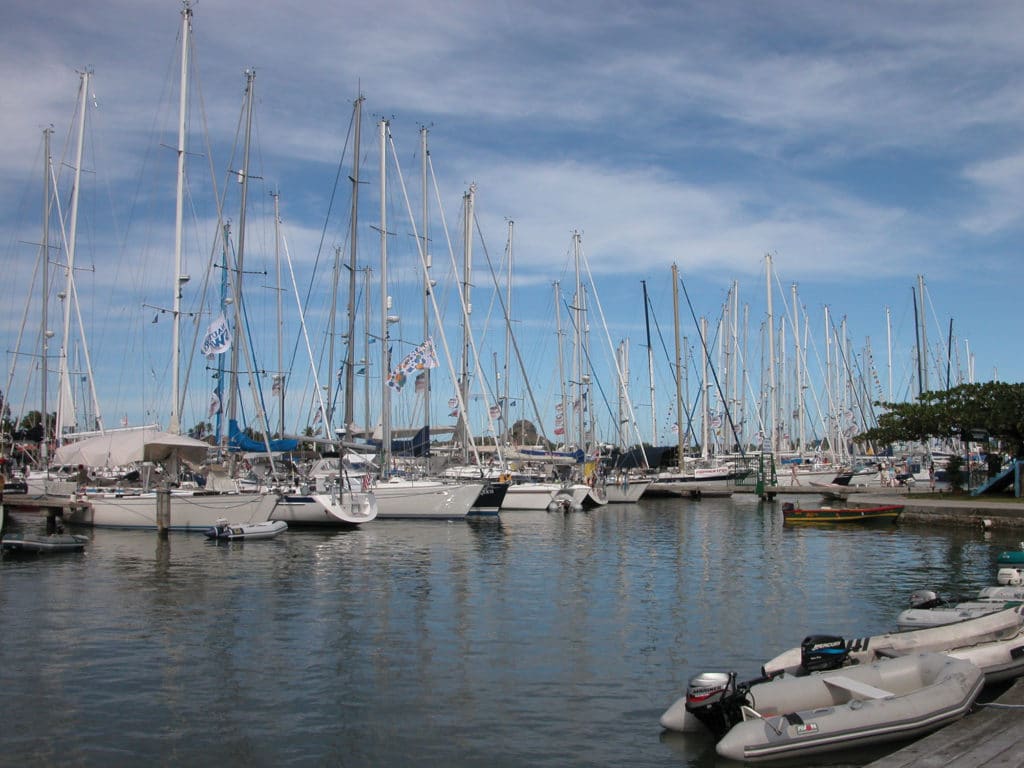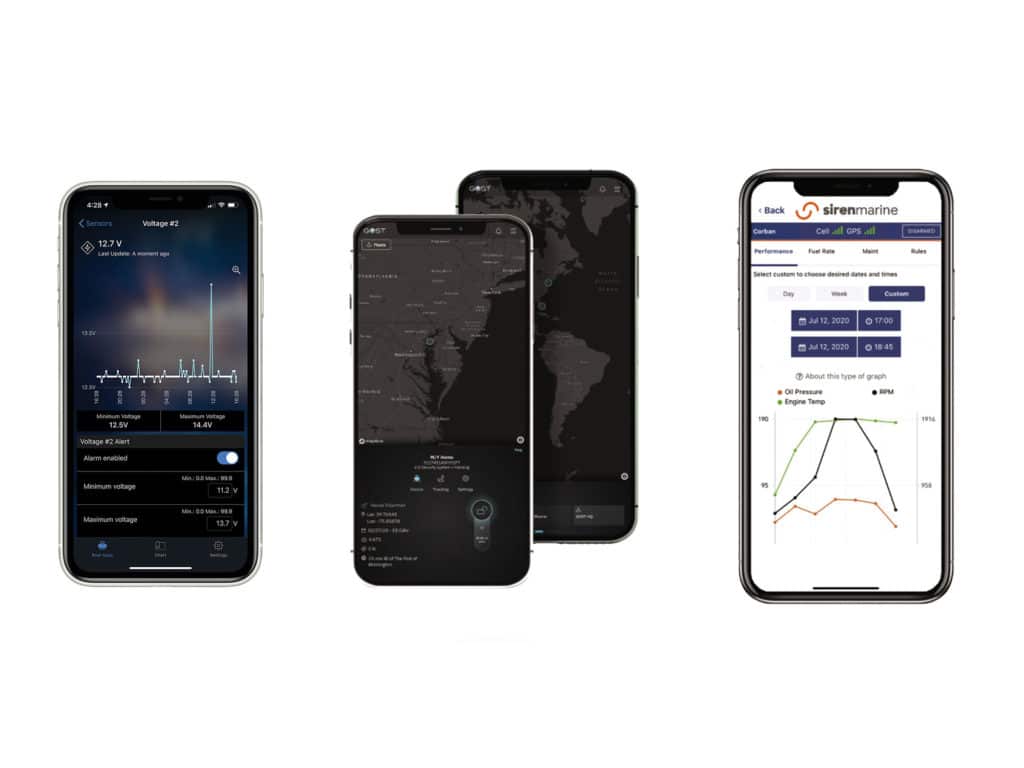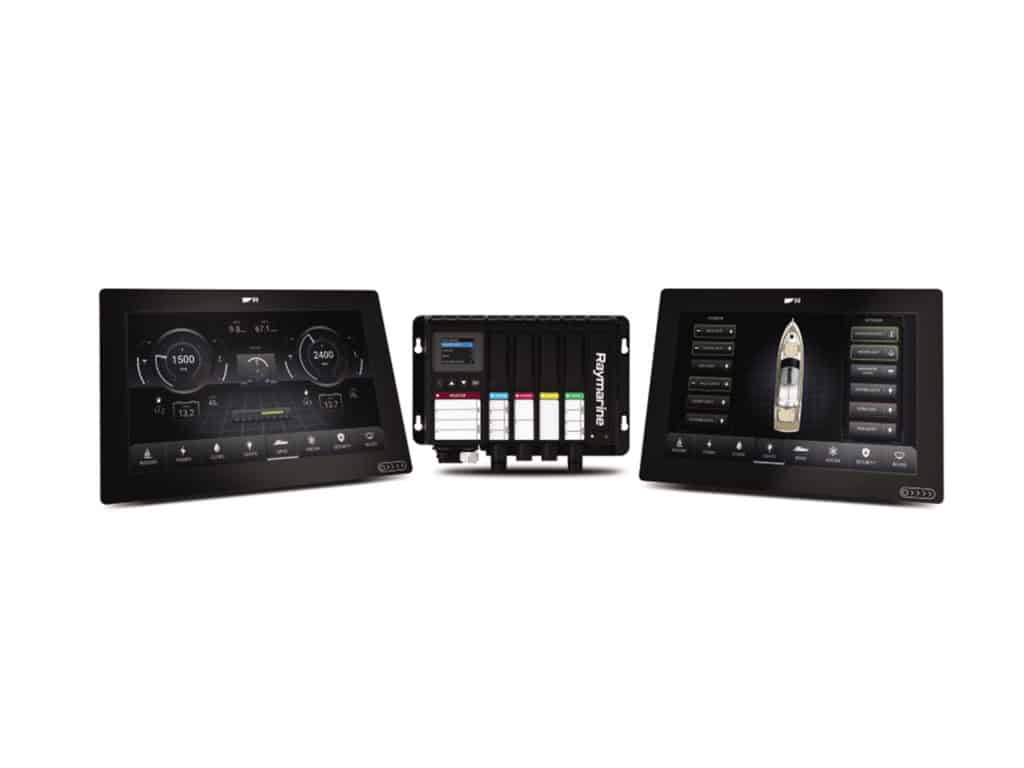
With boatbuilders intent on launching yachts filled with all the comforts of home, it was only a matter of time before they would find a way to put control of those comforts at a skipper’s fingertips—all thanks to the rapid convergence of onboard communications, digital switching, app-based software, and smartphones and tablets. But how does one actually create a smarter boat? This being 2022, let us count the ways, as sailors have several compelling options for everything from new builds to refits.
But first, let’s start with a bit of foundation-laying backstory. So-called smart systems entered the everyday lexicon with the advent of the smartphones—and then devices such as the Nest Learning Thermostat (early 2012), Ring video doorbells (2013) and Amazon’s Alexa (2014). While each fulfilled a different niche—which included delivering remote control over the furnace and air conditioner, remotely viewing front-door solicitors, and dimming the lights and queuing a Barry Manilow track—all three harnessed cellular and Wi-Fi communications, app-based software, and smart screens to give users better control over their domicile.
Soon, similarly smart technologies began migrating aboard sailboats, especially as satellite communications and cellular networks expanded and onboard Wi-Fi networks became more prevalent. The final piece of the puzzle has been the advent of digital-switching systems that replace fuses and analog switches with current-measuring devices and electronic switches across NMEA 2000 networks that tie everything together.
This evolution of life aboard came about relatively quickly. Less than a decade ago, a cruising boat was fairly sophisticated if its owner could run a chart plotter with a radar overlay. Now, thanks to the advent of what’s known as monitor, track and control technologies, users can track their vessel and turn networked devices or systems on and off—and in some cases, enjoy next-level control of devices such as cameras and security systems—from a single screen. Cooler still, thanks to cellular, satellite and Wi-Fi connectivity, that screen can be anywhere.
Here’s a look at some of the market leaders (discussed in alphabetical order) and the strengths and utilities that each system affords.
Now OnDeck
On its surface (and as of this writing), Garmin’s OnDeck system delivers fairly basic tracking and control features because the product is the company’s first foray into this market. But to sense the potential of how things could evolve, it’s helpful to consider the other technologies that are in Garmin’s portfolio and how they could be integrated into OnDeck.
Hardware-wise, OnDeck currently consists of a GPS-enabled black-box module that’s NMEA 2000-compatible and comes with three proprietary sensors: security, temperature and shore-power detection, along with a 12-volt DC relay switch that can be used to turn an onboard device on and off (more on this in a moment). Users can add up to 33 additional sensors, plus an aftermarket LTE cellular antenna. On the software side, OnDeck was added as a virtual button to Garmin’s existing ActiveCaptain app and requires an OnDeck monthly plan for cellular data.
Now you see it: Moving forward, GOST plans to integrate its existing video-app feeds with Specter, which will give users near-real-time views of their vessels from almost anywhere.
Once installed, OnDeck allows users to remotely control their choice of five relay switches using the app. Some examples include masthead, saloon lights and courtesy lights, refrigeration, or a host of other onboard devices. OnDeck’s GPS capabilities allow users to set geofences that, if breached, trigger the system to notify the owner; owners also receive notification if the system detects, for example, abnormal bilge-pump activity, if it experiences a loss (or spike) of shoreside power, or if a security sensor is tripped. While these features afford peace of mind, OnDeck isn’t a security system per se because there’s a ballpark 15-minute delay between when a geofence or sensor is tripped and when an owner receives notification. That said, Dave Dunn, Garmin’s director of sales and marketing for marine, was clear that this notification latency will shrink as 5G networks come online, or when satellite connectivity is introduced.
This latter point brings us back to OnDeck’s possible future capabilities. Garmin’s popular InReach devices already serve as dependable two-way satellite communicators. While Dunn declined to comment on future integration between OnDeck and InReach devices, it seems fairly obvious that Garmin might eventually incorporate InReach capabilities with OnDeck systems. Moreover, while OnDeck users can control up to five networked systems or devices, Garmin also owns EmpirBus, which builds full-scale digital-switching equipment, so it’s fairly safe to assume that these systems will see future integration. Once this happens, and once InReach capabilities are drawn into the mix, OnDeck owners should have the ability to monitor, track and control their yacht from anywhere, irrespective of their boat’s cellular or Wi-Fi coverage.
Sailor-Friendly GOST
When it comes to vessel security and monitoring, few companies are as innovative as Global Ocean Security Technologies.
After all, this is the company that introduced GOST Cloak, a security feature that, when tripped, vaporizes a formulated glycol solution to create a thick, confusion-inducing belowdecks fog and triggers attention-getting strobes, sirens, and proprietary Acoustic Barrier Systems, all of which make robbing or stealing a boat decidedly unpleasant, if not impossible.
GOST has also long leveraged both cellular and satellite technologies to alert customers to onboard situations, from the relatively routine (bilge- and high-water sensors) to the relatively rare (vessel theft), and to also deliver high-definition-video imagery from the boat’s cameras to an owner’s phone or computer.
More recently, GOST introduced its next-generation satellite-based Specter vessel-tracking interface. Unlike its legacy systems, Specter takes a mobile-first approach with its software, which is optimized for smartphone use and control. While this software looks and behaves like an app, it’s actually a much more powerful website that works on mobile and desktop browsers and allows owners to control their GOST system from afar.
An owner can change the radius of their vessel’s geofence, from 1,640 feet to 4.32 nautical miles, and change the system’s reporting intervals from once every two minutes to once every eight hours, all with a few taps. Communication between a user’s phone or PC and vessel are facilitated by Inmarsat’s 14-strong network of I-5 geostationary satellites that deliver global coverage (except in high latitudes) and 10 times faster speeds, 100 times more data capacity, and significantly less latency than GOST’s cellular-based products.
Specter is designed to be backward-compatible with existing GOST systems, so long as an owner adds GOST’s new IDP antenna. In addition to delivering two-way satellite communications with the vessel and lower power consumption than older-generation GOST antennas, the IDP features an embedded accelerometer, which allows the system to automatically adjust its reporting intervals depending on the vessel’s speed. To take advantage of the variable intervals, the feature needs to be enabled on the Specter website, and it is available only for times when the boat is traveling at speeds greater than 2 knots.
Moving forward, GOST plans to integrate its existing video-app feeds with Specter, which will give users near-real-time views of their vessels from almost anywhere, and it also plans to integrate Specter with its line of Apparition security systems.
Beneteau’s Ship Control
While some of the hardware discussed in this article is available as an aftermarket upgrade, Groupe Beneteau takes a different tack with its Ship Control system, which is currently standard equipment on the First Yacht 53 and the Oceanis Yacht 54 and Oceanis Yacht 62.
Ship Control was inspired by the automotive industry and leverages multiplexing, an embedded computer, and a Scheiber-built digital switching system to give users total control over all onboard and networked systems and devices using any of the vessel’s touchscreen-enabled chart-plotter screens. Alternatively, users can also run Ship Control on a tablet, smartphone or laptop, provided that they’re connected to the yacht’s Wi-Fi network.
Ship Control employs a graphical user interface that presents users with visual representations of the boat rather than text, along with so-called actionable hotspots. For example, a page view might show the boat’s interior and give users the ability to turn lights on or off, or adjust the vessel’s air-conditioning system. In the case of lights, a single tap of the page could turn fixtures on or off, while double-tapping the icon for the interior lights pulls up a dimmer bar that lets you customize your onboard experience (similar dimmer bars also pop up for other functions).

Underway, Ship Control presents users with a display screen that delivers real-time information from the boat’s networked navigation and sailing instruments, while other pages deliver control over things such as the boat’s stereo. Real-time information about the yacht’s battery bank, as well as fuel, water and holding tanks, can also be viewed, as can engine information.
Ship Control was designed to make sailing more intuitive, and as a result, it also incorporates automation. For example, when nighttime running lights are turned on, the system automatically switches the boat from its daytime to nighttime operating modes. The system even includes a remote battery switch to turn batteries on and off with a single tap.
While Ship Control delivers a user-friendly way of controlling all onboard systems, it doesn’t provide any security or vessel-tracking capabilities, nor does it allow users to control networked systems and devices from afar; a control tablet or smartphone must be connected to the vessel’s Wi-Fi hotspot. That said, multiple wireless devices can be simultaneously networked to Ship Control. This enables, for instance, the captain to let both watch captains have control over the boat for passages, and it can allow multiple DJs have run of the stereo.
Raymarine Hits the Bricks
While Raymarine’s YachtSense system doesn’t offer security or tracking capabilities—as of this writing, anyway—it delivers significant digital-switching capabilities for boatbuilders and owners. In essence, YachtSense relies on modules—or “bricks,” as Raymarine refers to them—that are designed to control specific types of electrical devices, such as lights, air conditioners, windows and tank monitors. Think of the bricks as Lego pieces that can each control up to four devices, and that can be stacked together to create an onboard network that’s accessed and controlled via a Raymarine Axiom multifunction display. The system can also include Wi-Fi capabilities, meaning the captain can control and monitor all onboard electrical devices from either the helm or remotely via a smartphone or tablet using the RayConnect app.

The basic system includes a master and power module. To that, various other modules are added, as needed. High-power modules are designed for high-consumption devices such as pumps, fans and refrigeration. Low-power bricks run lights and similar loads. There is a reverse-power module to control things such as hydraulic pumps, sunshades and windows. And there is a signal module for tank, battery and temperature monitors, as well as other sensors.
Three layers of redundancy are built into the network, which also includes a keyboard and LCD screen for running system diagnostics. Should a problem arise, devices can be switched on and off using the keyboard. There are manual fuses that can also turn power on and off, should a module fail.
Siren’s Call
Monitor, track and control technologies might be fairly new, but Siren Marine has been developing this technology since 2011. In 2017, the company launched its Siren Marine MTC system, which featured an embedded 56-channel GPS receiver and 3G cellular modem that gave users the ability to monitor critical onboard data such as bilge levels, to create geofences, and to control networked devices and systems via the MTC’s remote-switching capabilities. The system was run using Siren Marine’s app (Android- and iOS-compatible), and required a Siren airtime plan.
The only real drawback was the system’s dependence on shore-based cellular networks.
The company’s next-generation Siren 3 Pro replaced MTC and solved the offshore connectivity problem by adding the optional ability to network the system with a third-party satellite antenna. Once installed, Siren 3 Pro owners can track their vessel and control its networked systems from anywhere using their smartphone and the system’s built-in 4G LTE cellular or satellite modems and Siren’s app. As with Siren’s previous-generation offering, users can add additional wired or wireless sensors to monitor movement and other factors affecting a yacht’s security, or they can bolster their convenience factor by adding shore-power sensors or switched sensors that allow them to control networked items from afar. Plus, thanks to Siren 3 Pro’s built-in GPS receiver, the system alerts an owner if a boat breaks its user-specified geofence and provides real-time location information.
Siren 3 Pro was also designed to deliver remote-control capabilities by offering higher levels of digital switching, NMEA 2000 compatibility, and compatibility with CZone digital-switching systems. Owners have the ability to control all CZone-connected systems and devices rather than just the items that are directly networked to the Siren 3 Pro. Additionally, users can customize their systems’ parameters. For example, a captain could set alerts for maximum or minimum battery voltages. Or the crew could create automated modes, say, for daysailing, night sailing or night motoring, with a single screen tap.
David Schmidt is CW’s electronics editor.








